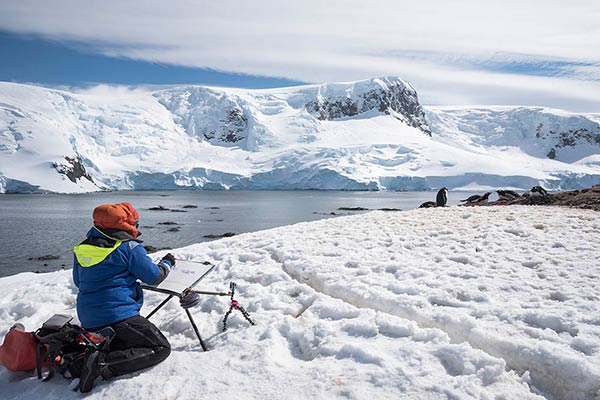David McEown paints in both the Arctic Circle and Antarctica each year. He’s learned some fascinating things along the way.
Lead Image: David McEown painting the Gentoo penguin colony at Mikkelsen Harbor in Antarctica last year. Photo by Daisy Gilardini
First things first. The two areas are on opposite sides of the globe, but are both ice-locked freezers. How are they different, and in what ways are they the same? McEown, who for the most part has visited each pole every year for 15 years, points out that the Arctic is ice and water surrounded by landmasses, while the Antarctic is a continent of land topped with ice and surrounded by water. But they also have very different vibes.
“I feel a sense of sentimentality in the Arctic,” says the Canadian painter. “It kind of feels like home. Humans have been living in the North for a long time. The Inuit people have a connection with the land. And the area has been modified by native people herding animals and hunting.
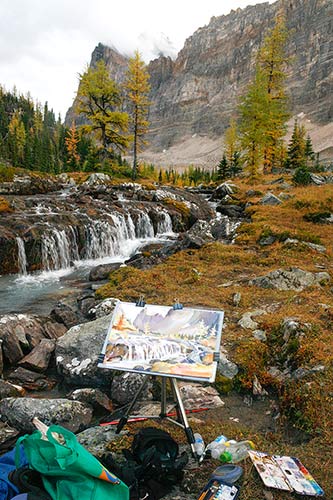
“In Antarctica, there is an innocence; it feels like another planet. Penguins walk right up to you. They are unfamiliar with humans and have no fear. I really like that. There is so much energy, with a density of wildlife. The rooks of penguins are just something else.”
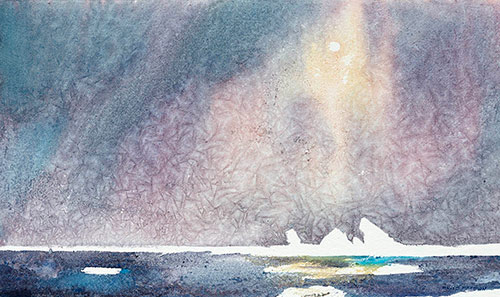
McEown says both poles serve as a reset button for him and his companions, but in different ways. Antarctica has the innocence, and the grandeur of enormous icebergs—”an unbelievable mass of ice,” as he puts it. The Arctic is home, and he feels a camaraderie with people there, braving the extreme and hostile environment. “I guess you could say I’m kind of bipolar,” McEown says with a laugh.
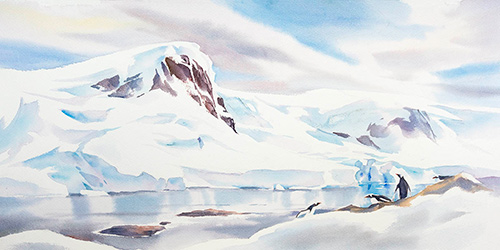
The environments on the ends of the Earth serve as reset buttons for another reason. “It is absolutely wonderful to be reminded of the fragility and preciousness of life,” McEown says. “It reminds us of how small we are, how all our worries are pretty insignificant. I find that inspiring and motivating, to have a reference for what we have. There’s also just the sheer wonder of it all. It is harsh, but if you know how to deal with the environment, it can be very comforting.”
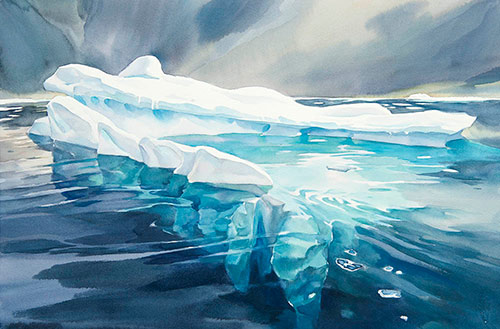
McEown says he also feels that his depictions of the landscape — especially in the Arctic — are important documentation of the rapid changes occurring. He isn’t particularly interested in discussing the source of climate change as much as clearly showing its increasing effect. “These places are changing in front of our eyes,” says McEown. “These museums are melting, and will never be again. We as humans are witnessing it. It’s an amazing time to be a painter.” He has seen the changes firsthand. In the Antarctic, McEown has painted the same rock over years, and watched as penguin species change, with the penguin better suited to a warmer climate coming to dominate. He has noticed an increase in precipitation, and an early start of it in the year. “Penguins are having to walk a lot further to get to open ocean,” he says. “And in the Arctic, one glacier that I visit used to come right down to the ocean. Now we have to take a helicopter and try to find it up there on the mountain.”
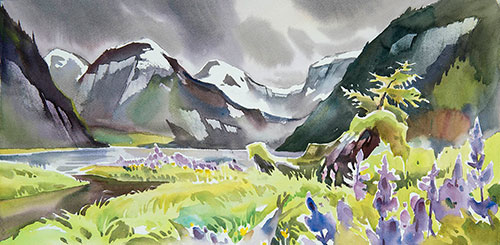
Once McEown finds and settles on his subject matter, he has to deal with the climate, which at certain times of the year means sub-zero temperatures. “Yes, the challenge of painting in these environments is the temperature,” says the watercolorist. “It does have an effect on the pigments. The climate interacts with your painting. I sometimes allow the frosted effect by just letting the paint freeze, and trying to manipulate that by letting it crystallize. A wash can freeze very quickly, and a spray of salt water may hit it, and it’s just amazing. I’ve tried duplicating it at home with a freezer and I couldn’t.”
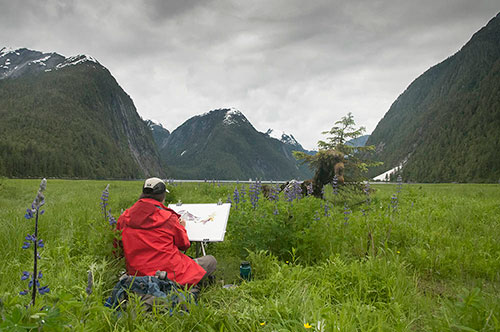
How does he keep his paints from freezing? McEown holds his palette, which allows his hand to warm it up somewhat. He has at times taped a hand warmer to the bottom of the palette. (McEown recommends a plastic palette, as he finds it doesn’t freeze as fast as a metal one.) But mostly, McEown suggests creating a microclimate around you and your palette. This essentially means creating a windbreak.
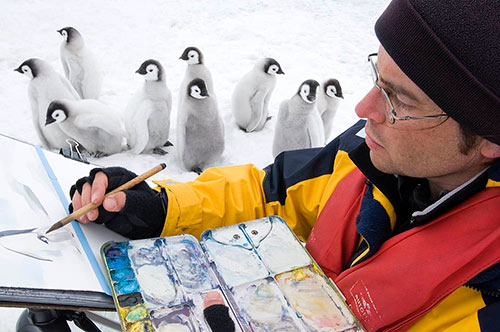
“Wind is the biggest problem,” he says. “I’m always creating a bit of a shelter.” McEown says it is to his advantage that he works in watercolor, because having his hands lower and pointing down allows blood to flow to them more efficiently. “The circulation is different because of gravity,” says the artist. “It’s amazing. Even when I hold my camera up to my face to take photographs, my hands get colder more quickly.”
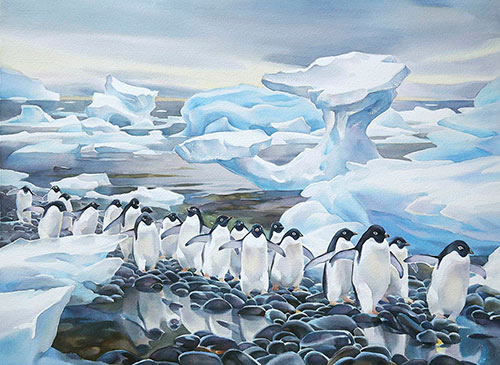
Final tips for painting at the poles? Consider using a bit of rubbing alcohol to keep the paint water from freezing. In extreme conditions, consider mixing a bit of oxgall medium and glycerin to the paint to create a slightly greasy mix. This will complicate drying times, so beware. Find neutral-tint sunglasses, because the light at the poles can create snow blindness just from its reflection off the white watercolor paper. And finally, try to maximize your comfort. Eat good food, for you will need energy. “Being comfortable is the most important thing,” says McEown.
Look for a full feature on McEown and his work in the next issue of PleinAir magazine.

